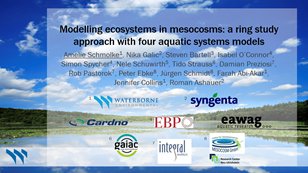
Aquatic Systems Models: A Virtual Mesocosm Could Be A Regulatory Tool of the Future
Aquatic mesocosm studies have long been considered a higher-tier tool for informing risk assessments under European regulations. These simulated pond studies are designed to investigate the impact of a pesticide on an aquatic ecosystem and use the complexities of multiple trophic levels and long-term study duration to observe patterns of impact and recovery.
As presented at this year’s SETAC EU, Waterborne is currently coordinating and providing technical expertise in a collaboration mesocosm project funded by Syngenta, along with Cardno, Inc., EBP and EAWAG, gaiac, Integral Consulting, Inc., and Mesocosm GmbH. The project’s goal is to demonstrate how realistic representations of the food webs and environmental conditions in mesocosms will open the door to running virtual mesocosms while extrapolating available mesocosm data to untested conditions, including time-variable exposure patterns.
To this end, we are working to apply multiple aquatic systems models to mesocosms in a ring study. This will become the foundation for establishing a virtual mesocosm. The development of a virtual mesocosm, through an aquatic systems model, would serve as a risk assessment tool to consider estimated effects under various conditions and will go beyond the experimental limitations of high-tier studies. The work to harmonize model input parameters (efforts to calibrate and validate the models are underway in this long-term project) using control mesocosm data from seven studies spanning across four years.
The ring study approach offers a unique opportunity to compare different models and gain understanding of the mesocosm systems. In this project’s ring study, four aquatic systems models are included: AQUATOX, CASM, Streambugs, and StoLaM+StreamCom. These models were selected since they are capable of simulating aquatic food webs, able to mechanistically represent interactions within the food web, offer different modeling approaches, and are capable of being adapted and parameterized for the unique needs of a mesocosm study.
To learn more about our findings so far, check out our recent presentations from SETAC Europe 2021. We are excited to be part of the team investigating novel ways for ecosystem models to inform the higher-tier risk assessment process.

Waterborne Environmental, Inc. Hired to Create Online Dashboard That Tracks Nutrient Loss Across the State of Missouri
READ MORE

Swimming with Bacteria: Water Quality Concerns at the 2024 Paris Olympics
READ MORE

The Right Tool – Multidimensional Models
READ MORE



